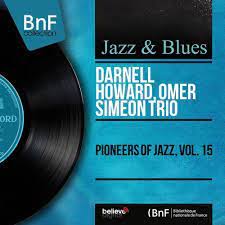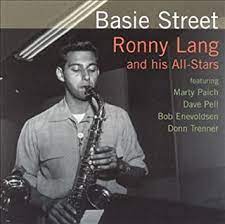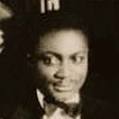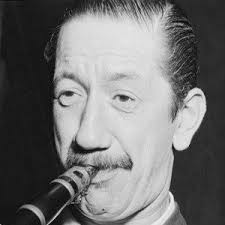
Daily Dose Of Jazz…
Darnell Howard was born on July 25, 1895 in Chicago, Illinois and began playing violin at age seven, picking up clarinet and saxophone later in his youth. He began playing professionally with John H. Wickcliffe’s Ginger Orchestra from 1913 to 1916.
Moving to New York City in 1917, Darnell played and recorded as a violinist with W. C. Handy, then headed back to Chicago, where he led his own band, played with Charlie Elgar before joining James P. Johnson’s Plantation Days Band, which toured London, England in 1923. The following year he toured Europe again as a member of the Singing Syncopators that also played in Shanghai later in the decade.
His Chicago years saw him playing with Carroll Dickerson, King Oliver, and Erskine Tate, Jerome Carrington, Dave Peyton and Earl Hines. He led a quartet in 1928, but his jazz violin is featured on the Hines band’s February, 1933 recording of the Earl Hines/Jimmy Mundy swing composition Cavernism.
In the late 1930s, Howard was freelancing into the Forties and playing with Fletcher Henderson and Coleman Hawkins, and putting together another band in Chicago from 1943 to 1945. He would go on to play with Kid Ory in California for part of 1945, then returned to Chicago and back again in 1948 with Muggsy Spanier until 1953. His only recordings as a leader were done while he worked with Bob Scobey in 1950, amounting to only four sides.
Through the 1950s he played with Jimmy Archey, rejoined Earl Hines to play Dixieland in San Francisco, California and recorded with Don Ewell on his 1956–1957 albums. Sometime after 1962 Darnell suffered a prolonged illness and after recuperating he played with Elmer Snowden, Burt Bales, and his own groups. His final tour in 1966, was in Europe as a member of the New Orleans All-Stars, then he fell ill again. Clarinetist, violinist and alto saxophonist Darnell Howard transitioned on September 2, 1966 in San Francisco.
More Posts: bandleader,clarinet,history,instrumental,jazz,music,saxophone,violin

Daily Dose Of Jazz…
Ronnie Lang was born July 24, 1929 in Chicago, Illinois. Sometimes spelled Ronny, his professional début was with Hoagy Carmichael’s Teenagers. He went on to play for a year with Earle Spencer in 1946, then with Ike Carpenter, and Skinnay Ennis the following year.
Gained attention during his two tenures with Les Brown’s Orchestra between 1949–50 and 1953 to 1956, he recorded with the Dave Pell Octet in the mid-1950s. During this time he moved to California and attended Los Angeles State College of Applied Arts and Sciences studying music and woodwinds.
By 1958 he had become a prolific and busy studio musician in Los Angeles, often employed by Henry Mancini. Ronnie played the iconic sax melodic line in Bernard Herrmann’s score for the 1976 movie Taxi Driver. He also recorded with Pete Rugolo, Bob Thiele, and Peggy Lee.
Alto saxophonist Ronnie Lang, who also played flute and clarinet in the bop, progressive, big band, swing idioms, is now retired at 92.
More Posts: bandleader,clarinet,flute,history,instrumental,jazz,music,saxophone

Daily Dose Of Jazz…
Örjan Kjellin was born on July 21, 1944 in Ljungby, Sweden and didn’t pick up the clarinet until the age of 15 and two years later formed his first band in partnership with pianist Lars Edegran. The band played music in the New Orleans style. He made his first records in his native Sweden at the age of 17.
Moving to New Orleans, Louisiana in 1966 he became a regular performer at several leading jazz venues including Preservation Hall. In 1968 he was a founder member of the New Orleans Ragtime Orchestra. He also led his own bands in the city including, in 1970, a band which held a residency at the Maison Bourbon Club. Two years later he formed the New Orleans Joymakers.
He recorded with several veteran New Orleans musicians including Josiah ‘Cié’ Frazier, Preston Jackson, Jim Robinson, Jabbo Smith, Zutty Singleton and Kid Thomas Valentine. In 1978, Örjan played with NORO for the soundtrack of the movie Pretty Baby. The following year he appeared in New York City as musical director, co-arranger and on-stage clarinetist with the stage musical One Mo’ Time.
In the early 80s he appeared with the same show during its long and successful run in London’s West End. Kellin has toured extensively with his own bands and with bands formed largely from New Orleans veterans. In 1992 he made his first solo tour of the UK.
Clarinetist Örjan Kjellin, a gifted and highly musical player who is known to the jazz world as Orange Kellin, continues to fan the flames of the music of New Orleans.
More Posts: arranger,bandleader,clarinet,history,instrumental,jazz,music

Three Wishes
While hanging out at the Cathouse one evening Pannonica inquired of Rudy Powell as to his three wishes if they could come true and he told her:
- “I’d like to be equipped to further jazz.”
- “Through that I’d be able to promote a spotlight for musicians who’ve never had a chance and deserve some.”
- “I would try to effectuate a way to alleviate the cliques that have been developing through the years, and which have hindered some fine players from exploring their talents.”
*Excerpt from Three Wishes: An Intimate Look at Jazz Greats ~ Compiled and Photographed by Pannonica de Koenigswarter
More Posts: baroness,clarinet,history,instrumental,jazz,music,pannonica,saxophone,three,wishes

Three Wishes
When the Baroness asked Pee Wee Russell if he had the opportunity to get three wishes granted what would they be he responded with:
- “To make Monk happy on the stage at Newport.”
- “I’d like to become a better musician ~ providing I’m one now.”
- “To make enough to give my wife everything she desires.”
*Excerpt from Three Wishes: An Intimate Look at Jazz Greats ~ Compiled and Photographed by Pannonica de Koenigswarter
More Posts: baroness,clarinet,history,instrumental,jazz,music,pannonica,three,wishes



